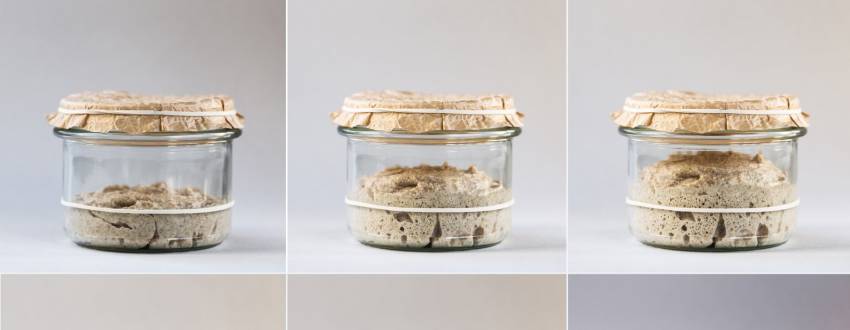Along with the mysterious toilet paper shortage, 2020 will also be remembered as The Year You Couldn’t Find Yeast.
The yeast shortage has motivated people to explore other options for making bread or challah – like sourdough.
Sourdough is both a science and an art.
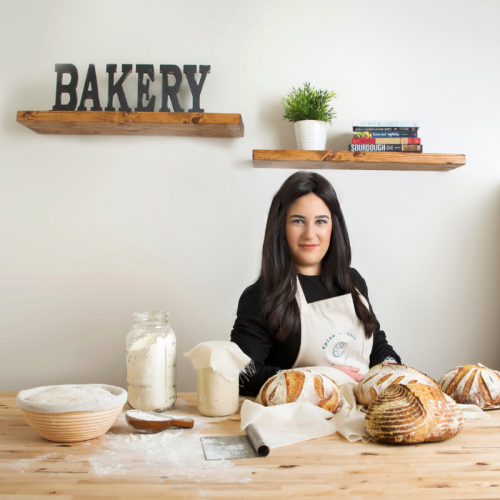
Sarah Leitner, AKA the Queen of Sourdough, graciously shared her sourdough tips and tricks with us. Sarah has a large online following through her website, spiceandzest.com, and her Instagram. She is also the founder of the Sourdough Institute, an online course that has already taught hundreds of students how to make sourdough bread easily.
A HEALTHY START
Sarah made her first sourdough starter seven years ago when her family was experiencing multiple health issues. The more research she did, the more she found that “diet affects EVERYTHING.” As part of her switch to a healthier lifestyle, she discovered sourdough.
What makes sourdough healthier?
Sourdough doesn’t use commercial yeast. Instead, you create a sourdough starter, which means you mix flour and water until it ferments, and good bacteria start growing in the starter. The good bacteria break down the gluten in the flour, so by the time you eat it, your body can digest it. The bacteria also have minerals and vitamins for us, like folic acid or vitamin B5.
Many people think they’re celiac, but really they’re just gluten sensitive because their body can’t digest the gluten. That causes inflammation. The starter in sourdough digests the food before you eat it. By the time you eat it, it’s all broken down. Your body can absorb all the good stuff that it needs, and the rest leaves your body because it’s not working on breaking it down.
Is sourdough gluten-free?
That’s a misconception people have. Sourdough is NOT gluten-free. It’s just that the process breaks down the gluten. So, people who have gluten sensitivity can eat it without feeling the adverse effect. I have thousands of people who thought they were gluten-free, took my courses, and now they say that they can handle sourdough.
But if you are for sure a hundred percent celiac, you have to find out for yourself if you can eat sourdough.
STARTING YOUR STARTER
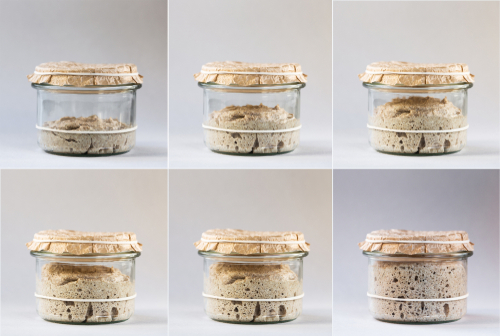
What is a sourdough starter?
A sourdough starter is a living thing. It’s wild fermented yeast, which is just flour, mixed with water. You let it sit until it’s absorbed, and it starts growing all the good bacteria on it. It’s like fermented pickles, fermented anything.
How do I make a starter?
You mix flour and water in equal amounts, always by weight. I recommend starting with 40 grams each of flour and water.
In the beginning, you’re going to have to feed it twice every day until it’s nice and active. Feeding means you put an equal amount of flour and water into the jar, into the existing starter. For each feeding, add 40 grams of flour and 40 grams of water consistently. But if you’re going to keep feeding it, you’re not going to have enough room. You’re going have an overload. So, you need to pour off a little bit every day, feed it, and keep it on the counter until it’s active. Then you can feed it as much as you need for whatever recipe you’re going to make.
What temperature should my starter be left at?
Room temperature. Between 71 and 78 degrees Fahrenheit.
What is the best container or jar to use?
It doesn’t matter as long as it’s not stainless steel. It could be plastic; it could be glass; it could be a jar; it could be a container. Anything works as long as you don’t seal it, and it’s not stainless steel. You can put either a towel over it or a plastic cover. I don’t screw on anything because you want the air for your starter.
What size should it be?
At first, it doesn’t have to be large because when you start, you don’t have to feed it a lot. You could start with a little jar.
How will I know when it’s active?
It’s active when it’s doubling in size or almost doubling in size every time you feed it. It should be full of bubbles, airy. You should be looking out for uneven bubbles, like bigger bubbles and smaller bubbles, not just like two or three bubbles. If you see only two or three continue feeding it until you see it’s really bubbly.
Should I add juice to my starter to be more effective?
Juice works because it’s full of sugar and the bacteria starts feeding on the sugars, but it’s really, really, really not necessary.
What kind of flour should I use?
Generally, I recommend bread flour. My favorite is King Arthur bread flour. But right now, just use whatever flour you can find. My whole script changed in the last few weeks!
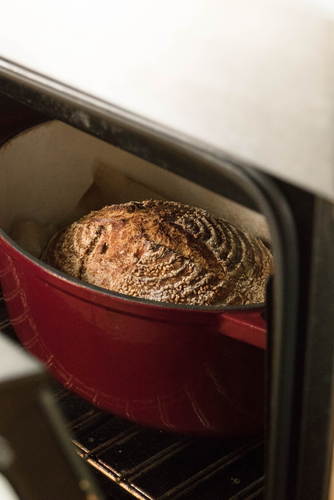
When is my starter strong enough for baking?
I would say after 7 to 14 days.
But I see a difference now that people are using different flours. There are different consistencies. Some all-purpose flours will take a little longer. So, if your starter is not ready by 14 days, don’t freak out, continue feeding it. Sometimes it could take up to three weeks.
What is a “float test?”
When you think your starter is ready to use, you can put a little bit of starter into a cup of water. If it floats, you know that your starter is ready. Because what makes a starter ready is all the bubbles and air pockets. So when you put it into the water, it’s floats because the bubbles are keeping it afloat.
If I forget to feed the starter, do I need to start over?
In the beginning, if you forget to feed your starter for more than two days, it probably will go dead, which means you’ll see mold on it. But generally speaking, a starter is very resilient, especially an established starter. If you forget to feed it once or twice, it doesn’t sit there and time you and be like, okay, it’s been 24 hours and 30 minutes. Just keep feeding it, to get it stronger, and to get a better product.
MAINTAINING AND USING YOUR STARTER
For how long do I feed my starter?
In the beginning, you should feed it twice a day until it gets active. Then you could cut down to once a day.
Then, when you feel like your starter is strong, you could store it in the fridge, and every time you want to use it, you take it out, feed it, use it, and put it back.
When is a starter ready to be stored in the refrigerator?
It’s a very good question, and most people don’t like this answer, but I just say you have to go with your feelings. I can tell you, “In 30 days, it’s going to be ready,” and then I’ll have people message me, “Oh, I feel like my starter is not really ready to go in the fridge.” And then I’ll have people who message me after three weeks, “I see that my starter is super strong. It grows really nicely. It makes great products.”
In general, with sourdough baking, it’s hard to give a timeframe; it’s more like a feeling. And once people get into it and they have an active starter, they’re going to see when it’s strong. They’re going to see a difference between week one and week five.
Can I freeze my starter?
I never tried. I don’t think I would recommend it.
How do I use my starter in a recipe?
You have to look at the recipe and see what it calls for. Let’s say your recipe calls for 100 grams of starter. You’re going to take your starter and feed it 50 grams flour and 50 grams water, six to eight hours in advance, or as long as it takes for your starter to become bubbly. Some starters take six hours. Some starters can even take up to 10 hours. And some starters could be ready in three hours.
You might need a larger container. Always keep in mind that however much you put into your container, you need at least double that amount in empty space so the starter can grow to twice its size. Otherwise, it’s going to overflow.
Once it’s bubbly, then you know that it’s ready to be used. Whenever you use your starter, make sure you leave over a drop so you can always feed it and have more for next time.
Do I need to use a food scale, or will measuring cups work?
You could probably find some recipes that measure in cups, but it’s really not recommended because a sourdough starter is full of bubbles. But air doesn’t weigh anything. So, if you have a cup of super bubbly starter, it’s going to weigh 200 grams. But a cup that’s not fully bubbly is going to weigh 300 grams because there’s much more starter in there. So, your bread may come out more or less dense if you’re using cups.
Can I substitute it for yeast in my favorite challah recipe?
Yes, there are conversions. You can substitute one cup of starter for each packet of yeast. Then take away 1/2 cup of water and 3/4 cup of flour from the recipe because of the water and flour in the starter.
How long will a starter last?
It could stay in the fridge indefinitely. My starter’s nine years old! Technically it could last months in your fridge without feeding it, but I do recommend feeding it at least once weekly just to get it strong and active and keep it going.
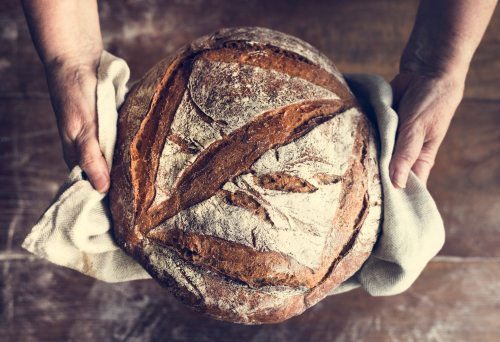
TROUBLESHOOTING
How can I tell if my starter is still active?
When it’s not active anymore, it’s going to start to dip. All the bubbles are going to start to deflate, and it’s going to have a liquid consistency. Then you know that your starter is not active anymore, which means it’s not dead, but you have to feed it again and wait until it’s bubbly before you use it. That could take another six to eight hours, depending on how strong your starter is and the temperature in your house.
Can I revive a dead starter?
It’s possible to revive a dormant starter that doesn’t look like it’s bubbly and active. You might have to give it a few extra feedings twice a day for a few days. The only time a starter is dead is if you see mold or if you have a starter that smells really, really terrible. If a starter just has a bad yeasty smell, that usually just needs a reboot, so to speak. You just need to feed it again and again until it starts to mellow out. But if it’s so bad that you don’t even want to open your jar, that starter would be dead.
What’s the black liquid that forms on top of a starter?
That’s called hooch. On a very simple level, it’s a starter’s way to say, “I’m hungry. Feed me.” So, all you have to do is pour off the hooch and feed it 40 grams of flour and water.
NOT ONE, BUT TWO BONUSES!
Are you ready to bake your own sourdough? Here are two bonuses to get you started:
Coupon code
For a limited time, Sarah is offering FREE access to her Sourdough Starter class.
And if you want the full treatment, grab this coupon code – KDC10 – for 10% off Sarah’s full course, found here. Registration is open now, and the coupon is valid until 6/24/20.
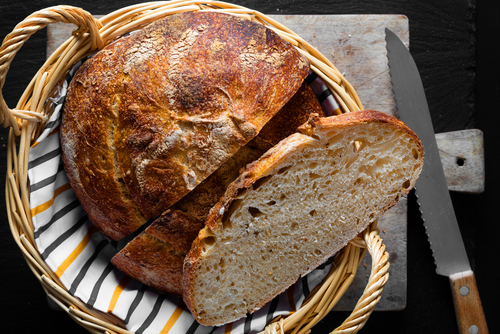
Can you share your favorite sourdough recipe?
In another exciting bonus, Sarah is sharing one of her proprietary sourdough recipes. She lays out all the steps, so you can bake like a pro:
BASIC COUNTRY LOAF -70% hydration
Remember to feed your starter 6-8 hours before baking.
100g leaven (bubbly sourdough starter)
450g white wheat bread flour
50g whole wheat flour*
350g warm water (325 for initial dough+25 for when adding salt)
10g salt
Prepping the dough
- In a large bowl combine 100g leaven and 325g of water and mix well.
- Add the whole wheat and bread flours and mix until well incorporated.
Autolyse
- Cover the bowl and leave to rest for 30-60 minutes.
- After 30-60 min of rest, add 25 g of water and 10g salt and knead until salt and water is combined into dough.
Bulk Rise (a.k.a. ‘bulk ferment’)
- Cover and set the bowl in a warm area (75-80 degrees Fahrenheit) for 3-4 hours OR for 6-8 hours in a cooler place (during the winter season, you can put it in a turned-off oven with a hot pan of water, or next to the stovetop near a pot of simmering water).
- During the bulk rise, perform stretch and folds every 30-60 minutes. Towards the last hour, fold more gently to avoid pressing gas out of the dough.
Bench Rest
- Scoop the dough onto the countertop.
- Lightly flour the top of the dough. Very gently turn over the dough so the floured side is face down, and fold the dough on all 4 ends, to gently shape into a round boule.
- Leave to rest for 20 minutes. The edges should be round and thick (it’s ok if it flattens a little), but they should not taper off. If they do taper or flatten off, reshape and let sit for another 20 minutes (this is like doing another set of folds during the bulk rise).
Shaping
- Sprinkle a lined bowl or banneton with flour.
- Fold bottom third up, right side third over, left side third over, top third over and then roll the entire loaf over and gently pull toward you, letting tension form the loaf. Place in prepared bowl.
- Let rise for 3-4 hours at room temp or place in refrigerator for up to 12 hours (known as ‘retard’).
Baking
- Place your Dutch oven in the oven and preheat the oven to 500 degrees Fahrenheit.
- Gently place the dough into the Dutch oven and score the top of the bread.
- Bake at 500 degrees covered for 20 minutes.
- Remove lid, lower temperature to 450 and continue to bake for an additional 20-30 minutes until crust is a rich, dark amber color.
- Let it cool on wire rack.
*You can swap out the whole wheat to all white wheat.
Let’s get baking! Are you going to try making sourdough yourself?
Let us know how it goes in the comments below.


